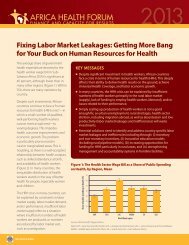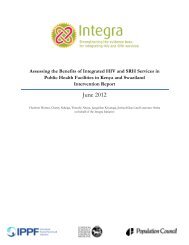ujh78
ujh78
ujh78
Create successful ePaper yourself
Turn your PDF publications into a flip-book with our unique Google optimized e-Paper software.
2010). Acute diarrhea can lead to severe dehydration; persistent diarrhea can predispose children to<br />
malnutrition and make them more vulnerable to other infectious diseases (Briend, 1990; Peterson Zwane<br />
and Kremer, 2007). HIV status; the socioeconomic status of the family; and community factors such as<br />
immunization coverage, health care access, and the quality of water and the availability of sanitation<br />
services all can have great impact on diarrheal mortality and childhood nutrition (Kosek et al., 2003).<br />
Findings from randomized, controlled trials suggested that vaccination, breastfeeding, and micronutrient<br />
supplementation can reduce the incidence of diarrhea, and, when diarrhea occurs, oral rehydration therapy<br />
can reduce the risk of dehydration (Peterson Zwane and Kremer, 2007).<br />
As Table 3.3 indicates, in the two weeks before the survey, the prevalence of diarrhea among<br />
children less than age 5 was quite different across countries, ranging from 8% in Madagascar to 25% in<br />
Burundi. Seven countries—Burundi, Cameroon, Ghana, Liberia, Niger, Senegal, and Uganda—<br />
experienced a level of child diarrhea above 20% (see Map 3.2).<br />
Sex and geographic disparities<br />
Overall, we did not find child’s sex disparities related to child diarrhea (see Figure 3.7). However,<br />
in Guinea (males: 18% and females: 15%) and Zimbabwe (males: 15% and females: 13%), the prevalence<br />
of diarrhea was two percentage points higher for boys than for girls (see Table 3.3).<br />
In half of the countries, the prevalence of diarrhea among children less than age 5 was higher in<br />
rural areas than in urban areas (see Figure 3.8). Five countries had a diarrhea prevalence that was at least<br />
four percentage points higher in rural areas than in urban areas—Burundi (urban: 22% and rural: 26%),<br />
Cameroon (urban: 19% and rural: 24%), Ghana (urban: 18% and rural: 22%), Mali (urban: 10% and rural:<br />
15%), and Niger (urban: 18% and rural: 22%). In contrast, in Senegal (urban: 24% and rural: 20%) and<br />
Tanzania (urban: 19% and rural: 14%), the prevalence of diarrhea was at least four percentage points<br />
higher in urban areas (see Table 3.3).<br />
The role of the household head’s sex and age<br />
In 13 of 23 countries, the diarrhea prevalence was higher for children living with a female<br />
household head than for children living with a male household head (see Figure 3.9). This difference was<br />
more than 3 percentage points higher in three countries—Rwanda (13% versus 16%), Senegal (21%<br />
versus 24%), and Tanzania (15% versus 17%) (see Table 3.3). The inverse situation occurred in Nigeria<br />
and Cameroon. In Nigeria the prevalence of diarrhea was 3 percentage points higher among children<br />
living with a male household head (11% versus 8%). This difference was more extreme in Cameroon,<br />
where the diarrhea prevalence was 23% for children living with a male household head and 17% for<br />
children living with a female household head, a difference of 7 percentage points.<br />
In Burundi, Kenya, and Uganda, the age of the household head played an important role in the<br />
prevalence of diarrhea among children less than age 5 (see Figure 3.10). As Table 3.3 shows, in Burundi<br />
the percentage who had had diarrhea in the past two weeks was 25% for children whose head of<br />
household was younger than age 50 and 31% for children whose head of household was at least age 50 (a<br />
difference of 6 percentage points). In Uganda 24% of children who lived with a household head younger<br />
than age 50 had had diarrhea recently, compared with 30% of those who lived with an older head of<br />
household—a difference of 6 percentage points.<br />
Variations during the last 13 years<br />
Six countries—Cameroon, Ghana, Kenya, Namibia, Tanzania, and Zimbabwe—have experienced<br />
an increase in the prevalence of diarrhea among children less than age 5 (see Table 3.2). This increase<br />
35








